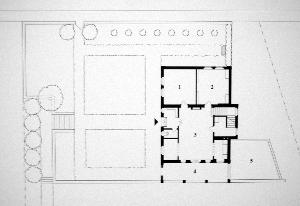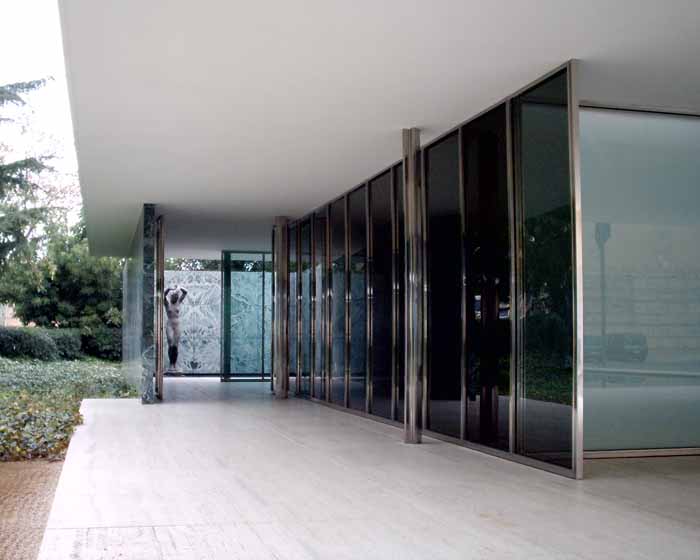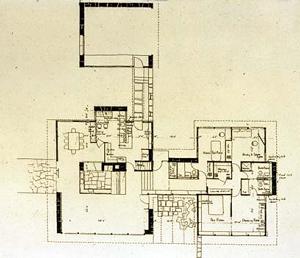I am finding that I really enjoy reading architectural theory;
this is a dangerous thing when it comes to writing an analysis of one or
another architect’s work or development of a particular idea. I, at least, cannot assimilate years of
research and philosophizing overnight. I
enjoy getting glimpses of a broad swath of history and the responses of each
architect to the forces at work around them; synthesizing and articulating the
insight I gain from those glimpses is difficult. But I will try to process out loud what I
have gathered in my few readings about Mies van der Rohe and Louis Kahn in
relation to the concept of the open plan.
Mies, it seems, approached architecture in true modernist
spirit, posing a purposeful critique of past and existing modes of building and
design and advancing the development of current architectural thought through
his works. Hartoonian emphasizes the role
that technology played in Mies’s thought and career. Mies saw technology as an important force
throughout architectural history, a key factor in the forms architecture has
taken and continues to take. Inevitably
new technology and materials will give rise to new experiments, new forms. Mies’s works exemplify this process of
experimentation and formulation over the course of his career from more
conservative explorations as in his earlier houses to more extreme examples as in
the Farnsworth House and the Barcelona Pavilion.
One of Mies’s earlier houses is the neoclassical Riehl House in Berlin, built in 1907. Compared to his later works, it feels basic, almost pedestrian. Its most distinguishing feature is a loggia of sorts integrated with a retaining wall on the side of the house furthest (and not visible) from the street. It seems awkward to me, unexpected and oversized. In plan, rooms are arranged around a central space and the walls are heavy boundaries between them. It is an exploration of the traditional role of walls and columns, clearly load bearing, unambiguous.
One of Mies’s earlier houses is the neoclassical Riehl House in Berlin, built in 1907. Compared to his later works, it feels basic, almost pedestrian. Its most distinguishing feature is a loggia of sorts integrated with a retaining wall on the side of the house furthest (and not visible) from the street. It seems awkward to me, unexpected and oversized. In plan, rooms are arranged around a central space and the walls are heavy boundaries between them. It is an exploration of the traditional role of walls and columns, clearly load bearing, unambiguous.
 |
| Plan, Riehl House |
 |
| Plans (unbuilt); Concrete Country House, Lessing House, Brick Country House; Mies van der Rohe |
 |
| Barcelona Pavilion (1929), Mies van der Rohe |
Taken to its furthest extreme, Mies’s exploration resulted
in the practical elimination of the wall altogether in the Farnsworth House and
his proposed 50x50 House. He questions whether
the wall is necessary at all, whether it can be usurped by the column entirely. Hartoonian talks about how this ardent
exploration led Mies to a conception that left behind culture and the concept
of dwelling. Indeed, this is proved by
the anxiety experienced by Dr. Farnsworth as she attempted to live in the glass
box Mies built for her.
Louis Kahn’s career also plays out a progression of thought
in regard to the open plan, but he starts his work much later, with the work of
Mies and Le Corbusier already well established.
He was born at the time Mies was building his earliest houses and did not
receive an independent commission for a house, the Oser House near
Philadelphia, until 1940. Saito
discusses how at this stage Kahn’s approach to the plan was in typical
modernist vein, subdividing a single volume of space with thin interior walls,
but from the get-go he is conscious of the whole picture, how the individual
room integrates with the other spaces in the house.
It does not take long for Kahn to start moving away from the
single, subdivided volume toward a more room-oriented approach that emphasizes
the individuality of each, though he sticks with familiar definitions of those
spaces. The plan of the Weiss House (1947-50)
makes this shift clear, separating programmatic zones into distinct volumes
connected via a narrower entryway/passageway.
In a way, this period for Kahn is analogous to Mies’ early period, a
similar exploration of established forms.
 |
| Plan, Weiss House (1947-50), Louis Kahn |
Subsequently Kahn began a higher level inquiry, abstracting
the concepts of the room and the house, looking for an order that would allow
the components of the whole to fall into place in a logical fashion. His use of controlling geometries in projects
such as the Trenton Bathhouse (1955) and the Adler House (1954-55; unbuilt) are
the beginning of his critique of the modernist approach to date in the way that
they elevate the room to a defining design element.
 |
| Plan, Adler House (1954-55; unbuilt), Louis Kahn |
Goldhagen quotes Kahn from the same time period: “Space made
by a dome then divided by walls is not the same space…. A room should be a
constructed entity or—an ordered segment of a construction system. Rooms divided off from a single larger space
must read as a completed space.” She
goes on to say that to Kahn “the important elements enclosing a space must be immediately
apprehensible, from structure to surface.
For this the open plan was inadequate because partitions, which were
customarily used to mark off spaces, masked a concentrated perception of the
building as a ‘constructed entity’” (Goldhagen 108).
In this Kahn’s development again parallels that of Mies,
though they subsequently went in different directions. Where Mies developed a theory of architecture
around the centrality of construction in terms of technology and its advance
(in constant motion), Kahn developed an architecture around the relationship of
construction to the observer in his place (a static perception). Like other architects of his time, Kahn was
responding to the lack of authenticity he perceived in many aspects of
modernism, which Mies’ work in its ambiguity exemplified.
Kahn’s emphasis on authenticity becomes evident in later
works as he experiments with different types of buildings and the way they relate
to the user. The Salk Institute (1962)
combines the monumental expression of the main structures with his very human
scale moves for the offices that connect to them. At the Kimbell Art Museum (1966-69) Kahn employs
vaulted ceilings resting on load bearing walls, using columns only where the
program needs open space. The open plan
is absent, broken up by the bays of the ceiling—and yet it is kept light and
airy, indeed human, through his innovative toplighting.
 |
| Kimbell Art Museum (1966-69), Louis Kahn |
It is interesting to see the progression not only of the
individual architects examined here, but also the progression in modernist
thinking. Kahn is able to pick up the
pieces of Mies’s deconstruction of construction and make something human out of
it. Perhaps Mies saw a shift coming—Hartoonian
notes the presence of “poetics of place” in Mies’ mid-career houses, houses from which
Kahn may well have taken important cues.
References
Colquhoun, A. (2002). Modern architecture: Oxford
University Press.
Goldhagen, S. W. K. L. I. (2001). Louis Kahn's situated
modernism: Yale University Press.
Hartoonian, G. (1989). Mies van der Rohe: the genealogy of
column and wall. Journal Of Architectural Education, 42(2),
43-50.
Saito, Y. (2004). Louis I. Kahn houses (Shohan. ed.).
Tokyo, Japan: TOTO Shuppan.


thank you for this post!
ReplyDelete